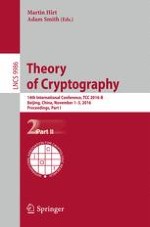2016 | OriginalPaper | Buchkapitel
Access Control Encryption: Enforcing Information Flow with Cryptography
verfasst von : Ivan Damgård, Helene Haagh, Claudio Orlandi
Erschienen in: Theory of Cryptography
Verlag: Springer Berlin Heidelberg
Aktivieren Sie unsere intelligente Suche, um passende Fachinhalte oder Patente zu finden.
Wählen Sie Textabschnitte aus um mit Künstlicher Intelligenz passenden Patente zu finden. powered by
Markieren Sie Textabschnitte, um KI-gestützt weitere passende Inhalte zu finden. powered by
Abstract
-
Introducing and formally defining access control encryption (ACE);
-
A construction of ACE with complexity linear in the number of the roles based on classic number theoretic assumptions (DDH, Paillier);
-
A construction of ACE with complexity polylogarithmic in the number of roles based on recent results on cryptographic obfuscation;
